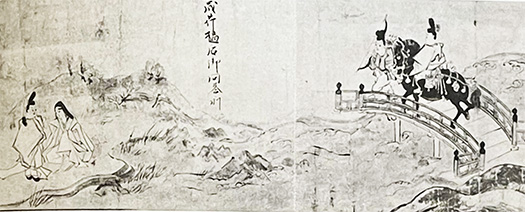


法隆寺宝物館「聖徳太子絵伝」記事、第15回目は聖徳太子27才の時の妻問い。ほぼ同時に世を去った愛妃「膳部菩岐々美郎女〜かしわで の ほききみのいらつめ」との出会い。このシリーズの第一回はこちら→端正なモダニズム「法隆寺宝物館」探訪。
この6−7世紀の飛鳥時代で27才での妻問いというのはやや「奥手」かと思う。聖徳太子自身も50才で死去しているので、王族であることも考えればこの女性以外にも妃はいただろう。3人、妃はいたとされているので、その中で最後に見初めた存在がこの女性だったのだろうか。この絵伝が忠実に準拠したと言われる917年成立の「聖徳太子伝暦」には「此の人は頗る合ぐ」という記述があるように、オシドリのように相思相愛だったという。
ついには太子が死ぬ前日に亡くなり、死ぬときはいっしょにとまで添い遂げた存在とされる。
膳部という氏族出身者で、膳村の近くに行幸されたときに、道端で野草のセリを摘んでいた3人の娘がいた。そのうちの2人は太子の行啓を知ると走り寄って奉迎したが、残る一人は顔も上げずにセリを積むばかりだった。太子は不審に思われて従者にその理由を問わせると「わたしは赤子の時にこの村の老女に拾われて育てられました。きょうはこの春はじめてセリ摘みに来ました。なるべく多くのセリを摘んで少しでも養育の恩に報いたく、太子をお迎えする余裕がございません」と言った。
太子はこの話を聞いてこころに留められ、娘を近くに召されてご覧になると、その麗質は玉のようで深くこころに恋情を抱かれた。ついにその娘を妃として迎えるべく、その夜、娘の家を訪ねることを約された。妻問婚。
村人たちは半信半疑だったというが、遅くなったけれど太子はこの娘宅を訪れ3日にわたって歓談されて、その後、輿を整えて娘を宮中に迎えられた。
太子とこの愛妃には四男四女ができたというから男女の相性も抜群だったのだろう。太子は「死後は共に埋葬されよう」と言ったと伝えられる。622年聖徳太子と共に病となり、太子が亡くなる前日に没した。聖徳太子の墓所である磯長陵(しながりょう)に合葬された。
膳という部民出身であり、膳氏は朝廷の食事を司る存在だったとされる。彼女がセリを摘んでいたのもそういう氏族としての当然の行為だったのだろう。膳氏は膳所など畿内周辺に地名としても残っている。
こういう男女としての愛情生活、そして動物への愛護のこころなど、聖徳太子という人物の傾向がうかがえてくる逸話だと思う。この女性が余念なくセリ摘みに打ち込んでいる様子に「惹かれ」たり、国内外から動物を贈られることが多かった事実を重ねたりしてみると、かれの内面のある部分が見えてくると思う。単純に言えば「まっすぐなるもの」への愛がポイントなのではないか。
その後の日本史が聖徳太子の個性を愛し続けたひとつのカギであるのかも知れない。
English version⬇
The Love of Prince Shotoku, the Daughter Picking Seri, The Gallery of Horyuji Treasures-15]
This work conveys the character of Prince Shotoku, who loved animals and honesty and frankness in his love affairs with men and women. The smiling love between a man and a woman lasted until his grave. …
The 15th article in the “Shotoku Taishi Pictorial Biography” series from the Gallery of Horyuji Treasures is about Shotoku Taishi’s wife questioning him when he was 27 years old. The 15th article in the “Shotoku Taishi Pictorial Biography” series, published by the Gallery of Horyuji Treasures, is about his encounter with his beloved wife, Kashiwade no Hokikiminoiratsume, who passed away at about the same time as Shotoku Taishi.
I think it is a bit “reserved” to ask for a wife at the age of 27 in the Asuka period of the 6th-7th century. Since Prince Shotoku himself died at the age of 50, there must have been other wives besides this woman, considering that he was royalty. The “Shotoku Taishi Denryaku,” which is said to be based on this pictorial biography, states that “this person was very compatible with each other like a mandarin duck,” as in the description “This person is very compatible.
It is said that they were as affectionate as mandarin ducks, and that they even died together the day before the death of the prince.
He was from a clan called Zenbu, and when he went to a place near Zen village, there were three daughters who were picking wild parsley by the roadside. Two of them ran to greet the Taishi when they learned of his visit, but the remaining one simply piled up the parsley without looking up. The Taishi became suspicious and asked the attendant why he was there. Today is the first time this spring that I have come to pick parsnips. I want to repay her for her kindness by picking as many parsnips as I can.
When the prince heard this story, he was deeply moved by her beauty and fell deeply in love with her. He promised to visit the daughter’s home that night in order to take her as his wife. Wife-questioning marriage.
The villagers were skeptical, but the Taishi visited the daughter’s home and spent three days talking with her, even though it was late, and then he arranged a carriage and welcomed her into the palace.
The prince and his wife had four sons and four daughters, so it is said that they must have been an excellent match. In 622, she became ill with Prince Shotoku and died the day before his death. He was buried in Isonaga-ryo, the grave site of Prince Shotoku.
She was from a tribe called Zen, and it is said that the Zen clan was in charge of the food of the imperial court. It is likely that her picking parsley was a natural part of her duties as a member of such a clan. The name “Zen” also remains as a place name in the Kinai region, such as Zensho.
This anecdote reveals the character of Prince Shotoku in his affectionate life as a man and a woman, and in his love for animals. If we are “attracted” to the woman’s devotedness to picking cherries, or if we compare it with the fact that he often received gifts of animals from home and abroad, we can see a certain part of his inner life. Simply put, his love for the “straight and narrow” is the key point.
This may be one of the keys to the continued love of Prince Shotoku’s individuality in subsequent Japanese history.
Posted on 6月 12th, 2023 by 三木 奎吾
Filed under: 日本社会・文化研究, 歴史探訪







コメントを投稿
「※誹謗中傷や、悪意のある書き込み、営利目的などのコメントを防ぐために、投稿された全てのコメントは一時的に保留されますのでご了承ください。」
You must be logged in to post a comment.